Sections News: pg. 2-3
Opinion: pg. 4-5
Centerspread: pg. 7-10
Features: pg. 11-12
In-Depth: pg. 13-14
Sports: pg. 15-16
Website

Find exclusive content and all archived stories: www.lhsepic.com
Social Media
Follow our Instagram @lhs.epic for breaking news, sports and event coverage
Volume 58 Issue 7 | May 8, 2023
Volume 58 Issue 6 | April 10, 2023

lost in translation.
Watch your tone! pg. 7
ASL education bridges communication between students pg. 7
Many languages may be speaking their last words pg. 8
Lynbrook High School, 1280 Johnson Ave., San Jose, CA 95129
Lynbrook High School, 1280 Johnson Ave., San Jose, CA 95129 GRAPHIC
Bilingual or bye-lingual? pg. 9
Words aren’t enough: exploring limits of translation pg. 9
WTF?! The origins of swear words pg. 10
How slang and emojis have slid into your DMs pg. 10
ILLUSTRATION
AMY LIU
BY
Letter from the Editors
Dear Vikings, Welcome to Issue 7! Our centerspread surrounding languages delves into topics ranging from meaning that’s lost in translation to the application of swear words in daily conversation.
Don’t forget about our usual coverage, either! In News, travel to Japan with the Japan Bowl team; in Opinion, delve into what it means to be “woke”; in Features, meet four of Lynbrook’s budding YouTubers; in In-Depth, learn about the politicization and history of drag; and in Sports, break school track records with senior Evan Taylor. Make sure to visit our website for exclusive content, including behind-the-scenes coverage of the InDesign fashion show and a video about students’ favorite song lyrics.
During spring break, 22 Epic staffers traveled to San Francisco for the annual JEA/NSPA Journalism convention. Six staffers won individual awards and the Epic took home a prestigious second place among scholastic publications from across the nation.
Get excited for Issue 8, our final issue of the year dedicated to the Class of 2023! Our seniors will be writing columns reflecting on their high school experiences. If you’re an underclassman, look forward to celebrating the Class of 2023’s senior bequeathals!
Good luck on your APs,
Elizabeth Cheng & Amy Liu
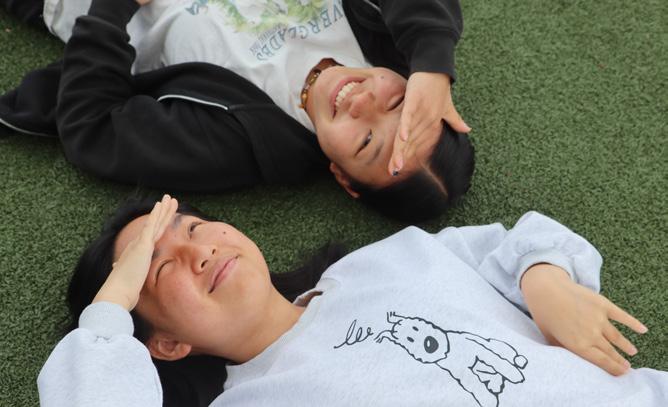 Editors-in-Chief
Editors-in-Chief
City to improve Lynbrook pedestrian safety
BY AUDREY SUN
To improve pedestrian safety and reduce traffic speed, the City of San Jose is proactively taking measures to add bulb-outs, or curb extensions, to the sidewalks at the intersection of Donington Drive and Johnson Avenue just outside the Lynbrook main entrance. Through the work of San Jose Vice Mayor Rosemary Kamei’s office and the Department of Transportation, the city also plans to create a safety plan for all public and private schools in San Jose.
“Lynbrook is an area where we have gotten community concerns about traffic and how fast the cars are going,” San Jose Vice Mayor Rosemary Kamei said.

The T-intersection of Donington and Johnson experiences heavy traffic during student drop-off and pick-up times, rendering it a hazardous area for bikers and pedestrians. These bulb-outs will narrow the road to force drivers to slow down, increasing pedestrian safety by offering a buffer area from cars. Bulb-outs are just one of the many features that the city has implemented in the community to ensure pedestrian safety.
“I think the addition of bulb-outs will
be helpful to students who walk to school because it will provide more room on the sidewalk, which will make it safer for us,” junior Cyrus Wong said.
To establish safer speed limits for pedestrians and bikers, DOT has employed a dedicated consultant to update engineering and conduct traffic surveys to reevaluate what should be the appropriate speed limits around school campuses. The city sources its data by sending out surveys to school principals, which allows them to identify specific issues related to each school and understand the needs and concerns surrounding its facilities.
“We’re locating areas around schools to see if there have been incidents with pedestrian crashes or if cars are driving faster than speed limits,” Kamei said.
Lynbrook is in an area which has received particularly numerous community concerns about the speed of traffic. A report of a student that was hit by a car during the 2021-22 school year was also a spark for the city to take the safety of student pedestrians more seriously. Due to this incident, DOT has planned to lower the speed limit near Lynbrook’s main entrance on Johnson
Avenue to 30 mph, but are awaiting the outcome of the study to make a final decision.
“Slowing down the speed limit will help to a degree, but people should be driving closer to a 25 mph limit any time they are close to schools that are in session,” Lynbrook crossing guard Tim Wehner said. “It might help community members, both elderly folks and younger children, who may cross further up Johnson towards Bollinger, which is great.”
In addition to the new safety measures the city is taking, Wehner suggests that drivers and pedestrians know the rules of the road as well as practice patience when the rush is on. Earbuds and phones are an unnecessary distraction for the 90 seconds or so it may take to cross any busy intersection.
“The risk-reward between a tardy and someone being severely injured is not worth taking,” Wehner said. “Parents can consider leaving the house earlier, and perhaps dropping off their student a few blocks away from the school, which could alleviate congestion.”
In June, DOT is expected to finish developing a school safety work plan with data from public and private schools.
Juul pays its largest settlement over minor-directed advertising
BY SAMYUKTA SARMA
On April 12, California announced that they would receive the largest settlement a state has ever received from Juul Labs. The company settled with six states, amounting to $462 million paid for advertising its e-cigarettes to audiences under 21 years prior to its company-wide reset in 2019, in which the company redefined its ethics after criticism.
“By using advertising and marketing strategies to lure young people to its products, Juul put the health and safety of its vulnerable targets and the California public at risk,” California Attorney General Rob Bonta said to the Mercury News. “Today’s settlement holds Juul accountable for its actions and puts a stop to its harmful business practices.”
training on it from the staff level, so we knew what to be looking for and what was happening,” Assistant Principal of School Climate Tara Grande said.
In 2019, an FDA investigation found that Juul was selling its products without appropriate authorization and implied that their products contained less tobacco than they did. Additional criticism and lawsuits from states over various issues resulted in Juul taking on a change in leadership.
$462
million paid by Juul for advertising its e-cigarettes to underage audiences of less than 21 years
Under new CEO K.C. Crosthwaite, Juul pledged to earn the trust of the community and rebuild relationships with public-health officials and policy-makers, with its primary goal of preventing the use of e-cigarettes among underage users redefining the brand.
nicotine as a pack of 20 cigarettes. Prior to a lawsuit from the state of New York in 2019, it was not disclosed on the packaging of Juul products or on its website that their products contain nicotine, nor did Juul define nicotine as an extremely addictive chemical derived from tobacco. A warning about nicotine is now disclosed on the packaging of Juul products and on the website, with an age-verification pop-up when browsing products as well.
underage users has plummeted, underage accessibility to vaping has not halted. Alternative brands, such as Puff Bar, are on the rise. In the 2022 National Youth Tobacco Survey, 14% of high school students and 3% of middle school students reported current use of e-cigarettes, with Puff Bar being the most popular brand.
Since 2019, Juul has settled with 47 states over 5,000 lawsuits, amounting to a total of nearly $3 billion. In its latest settlement, attorneys general from California, Colorado, Illinois, Massachusetts, New Mexico and Washington D.C. received compensation for lawsuits in their individual states, with California receiving the largest sum of $175.8 million. California plans to put the money toward education and prevention of e-cigarette use as well as research.
Launched in 2017, Juul quickly found itself at the center of a teen vaping epidemic as its flavored e-cigarettes rapidly rose in popularity among minors, even making its way to Lynbrook.
“That was when we started doing some education around it and having more
“I felt that the company and the category, quite frankly, needed a reset given the trajectory that we were on,” Crosthwaite said to Bloomberg. “There was clearly erosion of trust that existed for our company and for the category.”
While Juul never explicitly advertised to underage users, their products came in sweet flavors which appealed to the age group; they used young models and celebrity influencers in their ad campaigns; hosted launch parties for products and gave free samples to underage users at events.
“I’m sure that advertising from vape companies affects the number of students who vape, I mean, that’s why they do it: to hook kids young,” Grande said. “That’s why there are so many anti-vaping, anti-smoking commercials directed toward youth: they know that that’s what’s happening.”

One Juul pod, the cartridge containing the flavored liquid, contains as much

During its 2019 reset, Juul stopped all advertising in the U.S. and has yet to restart it. Additionally, Juul has discontinued all sweet flavors of its vape pens after backlash arguing that these flavors specifically appeal to underage users. The FDA is currently in the process of reviewing Juul after banning their products in 2022 after it alleged that Juul did not provide sufficient data in toxicology reports. While Juul’s products have reentered store shelves, the only flavors available for purchase are menthol and Virginia tobacco.
According to the National Youth Tobacco Survey, underage use of Juul products has declined by 95% since 2019. However, lawsuits from that era in Juul’s history continue to cost the company billions of dollars. Juul’s leadership has said that it continues to pay these settlements in order to atone for the company’s problematic past and show the public its commitment to transparency going forward.
“With this settlement, we are nearing total resolution of the company’s historical legal challenges and securing certainty for our future,” Juul said in a statement released on April 12. “Now we are positioned to dedicate even greater focus on our path forward to maximize the value and impact of our product technology and scientific foundation.”

Although the use of Juul among
“Whenever new products come on the market and we start seeing our kids be interested in them, we want to take action to do education and prevent it,” Grande said.
Of those who reported e-cigarettes use, 85% reported using flavored e-cigarettes, most commonly fruit-flavored, followed by candy and other sweet flavors, largely reflecting the legacy of Juul. While no amount of money can undo Juul’s actions prior to 2019, this settlement will contribute to the California government’s efforts to combat underage vaping.
02 NEWS the Epic
PHOTO BY CATHERINE ZHOU
PHOTO BY NICOLE GE
PHOTO BY INAAYA YOUSUF, GRAPHIC ILLUSTRATION BY INAAYA YOUSUF AND VIDUSHI UPADHYAY
"Magical language" captivates sophmores
BY CALVIN ZHOU
On May 3, San Jose-born poet and author E.J. Koh spoke with Lynbrook World Literature students, who listened intently as they learned of the struggles and triumphs Koh experienced while caught between his two cultures. Based on her experiences as a second-generation Asian American, Koh wrote “The Magical Language of Others,” a memoir filled with raw and emotional storytelling that delves deep into the complexities of family relationships, cultural identity and power of language. The book, newly introduced this year to diversify the World Literature curriculum, gave students a glimpse into a unique, yet relatable story.
“The book is a refreshing change from the others we read this year because of how relatable it is,” sophomore Brian Kao said. “Although we aren’t exactly the same, I felt like she told a story that I endured and experienced.”
Koh’s memoir takes readers on a journey through her teenage years when she lived in Davis, California with only her older brother after her parents moved to Seoul, Korea for her father’s career. Feeling a deep sense of abandonment,

oh struggled to find her identity and sense of belonging, unwilling to forgive her mother for leaving. The memoir weaves together letters that her mother wrote to her in Korean, stories of her ancestors and Koh's own experiences discovering who she is.
“There are some parts of it that some Lynbrook students may not connect to at all, like her parents living in a different country for a majority of her life,” sophomore Arnav Singhal said. “But the story of an Asian protagonist who has struggled with her parental relationships is very relatable to many of us.”
Although this is the first year that “The Magical Language of Others” is being taught in Lynbrook’s curriculum, Cupertino High School taught the book in the 2021-22 school year. In 2020, the district’s World Literature teachers were looking to add diversity to the largely eurocentric English curriculum. When “The Magical Language of Others” was published in January of that year, Cupertino World Literature teacher Lynn Chen, who knew Koh personally, suggested taking a more modernized approach to AAPI literature
Conquering the 31st Japan Bowl
BY CHELSEA LEE
In the 31st annual National Japan Bowl Championships on April 13 and 14, Lynbrook won second place in every competition level, surpassing nearly 200 students from 19 high schools across the U.S. After being quizzed on numerous topics from Japanese history to manga, ynbrook s teams have placed in the top five of all three levels for the second year in a row.
To compete, students must not be native Japanese-speakers or speak the language at home. Teams of two or three students are placed in levels two, three or four/ AP in accordance with the course level in which they are enrolled at school.

In the first round, students answer trivia questions and are tested on accuracy. The second round adds the factor of speed, as the top three teams face individual grammar questions and a team speed round. Because the questions draw from a broad range of content, they can be unpredictable and challenging.
“It’s hard when you repeatedly come across questions you don’t know and feel like ‘We’re not going to make it, we don’t know enough,’” Japanese teacher Jeremy Kitchen said. “Especially since our team studies throughout the whole year, it’s a really emotionally taxing competition.”
But in Kitchen’s experience, if a team answers about 80% of the questions correctly, it is likely that they will make it to the second round. He advises his teams to trust their gut feeling when answering questions.
“The major piece of advice I give them is to just trust the work that they put into studying and know that some of it is luck at the end of the day, in terms of what questions are asked, so not to be hard on themselves
if they don’t know something,” Kitchen said.
Immediately after passing the tryouts to create Lynbrook’s teams in October, the competing students immersed themselves in Japanese studies for more than six months. They met multiple times each week with their mentor, senior Benjamin Chang, for student-led study sessions. As a Japan Bowl competitor for the past three years and part of the first-place level four team last year, Chang used his experience to help motivate and prepare this year’s teams.
The first year I competed was during the COVID-19 quarantine, so there was a point when we hit rock bottom — where everyone’s motivation, including Kitchen Sensei’s, was really low,” Chang said.
“During that point, an upperclassman showed a lot of dedication even though everyone was ‘dead.’ That motivated me, and I wanted to become a mentor to act as a role model too.”
Lynbrook’s teams attribute much of their success to their selfaccountability and passion for Japanese learning. Looking forward to the Bowl next year, they plan to further develop their skills and maintain the work ethic of this year’s competitors.
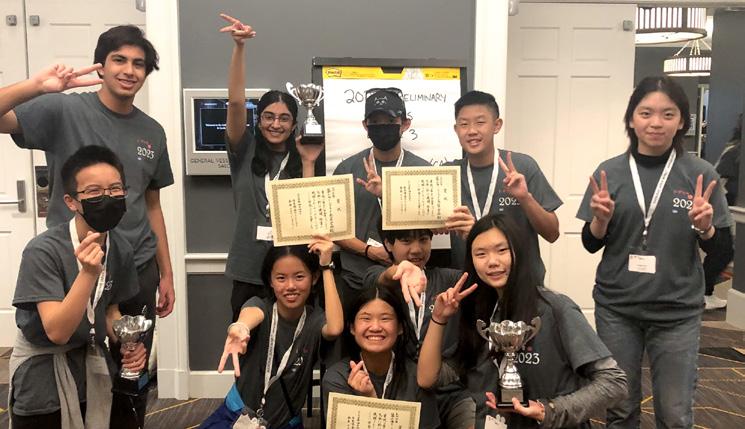
“I think the reason we were so successful is because we have a lot of passion for the culture and we work really hard toward winning,” senior Saahil Gupta said, who competed on the level four/AP team.
Cupertino High also placed in the top three for all three levels, making the moment event more special as Lynbrook’s teams stood on stage with a fellow FUHSD school
“It’s a wonderful thing to see the top places go to Lynbrook and Cupertino,” Kitchen said. “There’s a friendly rivalry but it was really fun to see both of our programs shine on a national stage.”
with Koh’s memoir.
“It was just great to have what I felt were both familiar and unfamiliar Asian experiences represented,” Chen said. “I appreciate that it helped my students — a lot of them being from an Asian American background — have some really great conversations about the ways that we receive or don't receive love from our immigrant
The teachers loved the book and felt it reflected the diverse student experiences on campus as it explores themes of cultural identity and family relationships, which many students grapple with. Many students expressed comfort in being able to resonate with the memoir’s
“It is one of the only AAPI texts that we would get the chance to read throughout our whole high school career,” sophomore Sophie Mak said. “It's an important book to me because it shows how life truly is for Asian Americans in America.” Scan QR code to continue reading.

Upcoming Viking Events
41st Annual FUHSD Art Show, May 1-23 Admire pieces of art created by FUHSD students in the district office lobby.
Senior Prom, May 12
Seniors will have their “Happily Ever After” at the Corinthian Grand Ballroom.

Senior Athlete Signing Day, May 15 Recruited athletes will be honored before continuing their athletic career in college.
Pops Concert, May 18
The music department, Viking Vocalists, and members of the Senior Skit will perform in the auditorium.
Indesign Fashion Show, May 19

Peer into “Pandora’s Box” with Lynbrook Indesign at the quad at lunch.
Campus Wellness Week, May 22-26 Students can have a furry therapy session with dogs and receive freebies.
No School Memorial Day, May 29
By Nicole Ge, Inaaya Yousef and Apurva Krishnamurthy.
03 NEWS May 8, 2023
Photo by Nicole Ge.
Author E.J. Koh explores themes of cultural identity with Lynbrook students during her virtual author visit.
PHOTO USED WITH PERMISSION FROM E.J.KOH GRAPHIC ILLUSTRATION BY APURVA KRISHNAMURTHY
Level four champions will go on a "Champions' Trip" to Japan paid for by the Bowl's organization and the Japan Ministry of Foreign Afairs' Kakehashi program.
Scan to read the full story
PHOTO USED WITH PERMISSION FROM JEREMY KITCHEN
Bomb threat or not, emergency drills are no laughing matter
On the morning of April 11, Lynbrook faculty identified a potential bomb threat that resulted in the cancellation of the rest of the school day and forced numerous students to leave their belongings in locked classrooms. Despite being unaware of the full scope of the situation, students and staff exhibited exemplary behavior in evacuating in an orderly and timely fashion. In the future, students should continue to stay alert and avoid becoming desensitized by emergency drills. While Lynbrook is in an area where such emergency situations rarely occur, being prepared and knowing how to react swiftly and calmly can make all the difference in the event of an actual emergency.
Residing in a relatively peacful community, students may feel that many of the crimes, tragedies and destructive weather events broadcasted on the evening news, exist only on television.

“Sometimes, these threats and drills are hard to take seriously because nothing really crazy happens at Lynbrook,” junior Nimalan Elanchelvan said.
Even with little information about the situation, it is essential for students to approach emergency protocols in a serious manner. Although repeated drills can seem tedious and disruptive to academics, these drills serve as vital tools in preparing students for real emergency situations.
“You need the drills, but at the same time, doing the drills can desensitize you to the seriousness when you actually have a real situation,” computer science teacher Brad Fulk said. “If you can’t identify the difference, which even the staff had a hard time distinguishing, since it was the fourth alarm in a month, none of us knew
that it was anything other than ‘business as usual’ when the drill started.”
Staf Editorial The Voice of the Epic
Despite the potential for students and staff to become desensitized, the drills’ repetitive and consistent nature has also been able to establish a standard for students’ conduct during an emergency and played an important role in maintaining the organized behavior of students and staff in response to the bomb threat.
“Lynbrook students and staff are very thoughtful and responsive to instructions,” Assistant Principal Tara Grande said. “The fact that we conduct drills regularly makes the students more comfortable with the evacuation process, and they know where to go and what to do in such situations.”
While the behavior of students during emergency drills and especially the bomb threat, has been commendable, some chose to cope with the boredom of the drill by socializing with friends or playing games on the field. owever, there is a time and place for students to express humor or have fun with their friends; emergencies or drills can be a complicated place to do so. While waiting for extended periods during lengthy drills with no clear and present danger or no indication from the faculty to the contrary, some degree of playfulness is expected, but students should remain vigilant and prepared to respond appropriately to potential emergencies.
“I think it’s okay if people are having fun and messing around because it is just a

way to pass the time,” sophomore Mahati Ramakrishnan said. “But if we get an update that shows the severity of the situation, people shouldn’t be running around, and faculty should know where all the students are.”
As outlined in the California ducation Code, schools are required to conduct several different types of emergency drills throughout the year. igh schools are required to conduct at least one fire drill per semester, whereas earthquake drills only have to be administered once in an academic year. The only drill not required to be conducted during the school year is Run, ide, Defend drill. School administration was unable to conduct such a drill this year, but is planning to hold one next year.
“A lot of the drills are mandated by the education code and required by the state,” Grande said. “Then, the planning and execution of safety measures are done school by school based on what works best for each school. The safety committee assists in planning, and the administrative team is heavily involved in the process.”
While it is easy to
become complacent in a community that seems immune to emergencies, it is crucial for students to remain prepared and vigilant, and to continue to take emergency drills seriously. By doing so, they can help ensure the safety of themselves and those around them in the event of an emergency.
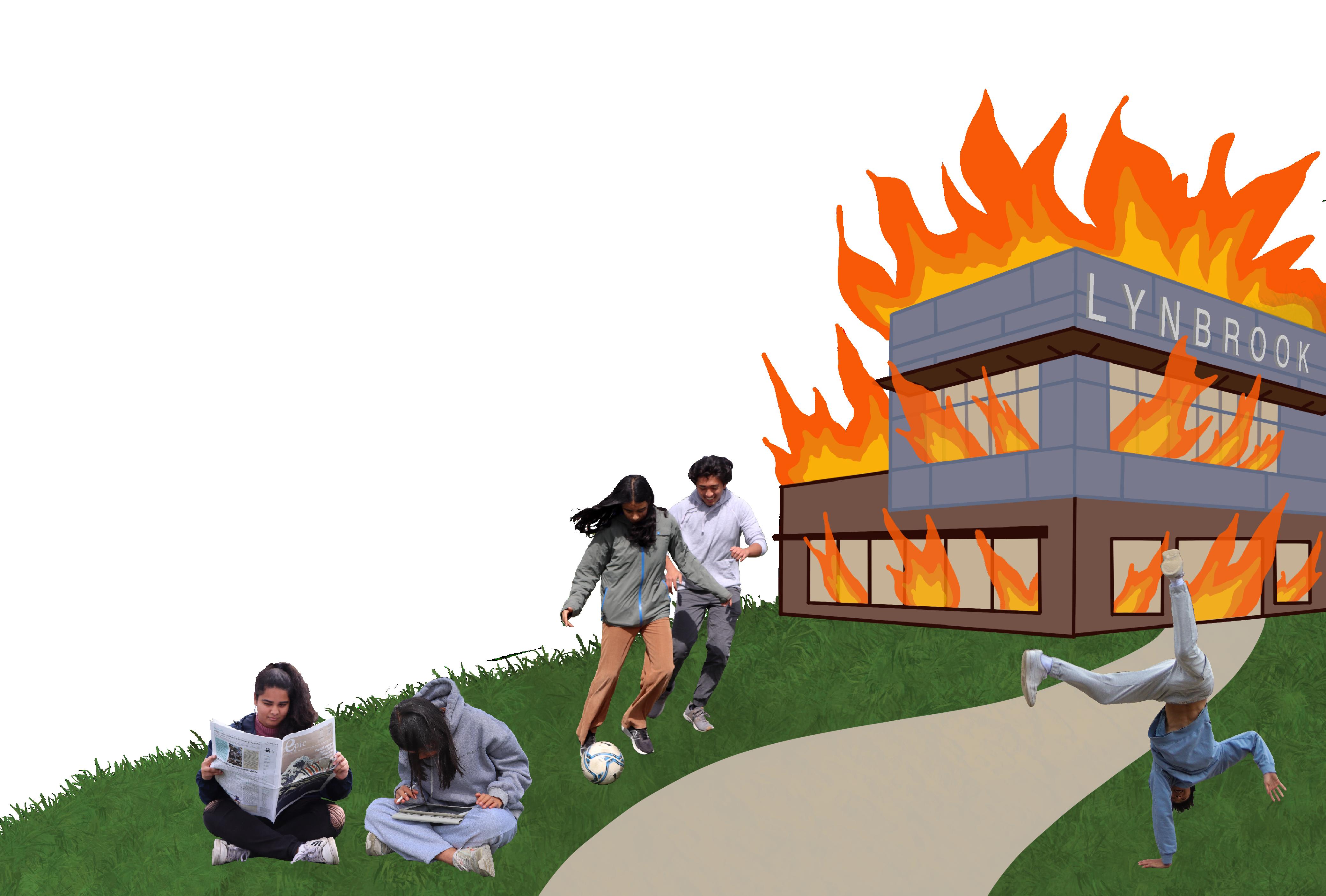
“We always strive to improve our safety drills, and I appreciate the cooperation and feedback we receive from our students and staff,” Grande said. “We have a safety committee, and any students interested in joining can contact me to participate in planning and provide a student perspective on safety measures.”
the Epic voted 32-0 in favor of this stance with 8 abstaining.
BY VALERIE SHU// IN MY OPINION
Finding my calling as a camp counselor
Lightning split the crimson sky as I aimed my flashlight into the gloomy dusk, surrounded by the chaotic voices of my campers while raindrops filled the air. Carrying heavy backpacking gear and half a week’s experience as a camp counselor, I scanned the storm approaching the mountainside during our first overnight hike with terror. The darkness made my campers blend in, but by now I could do a head count in my sleep. I took a shaky breath to calm my nerves before lifting my voice and taking the first steps down the rocky trail. “Follow me!”
ver since oining White Stag Camp one summer as a shy middle schooler, I had dreamed of becoming a camp counselor. Despite never having pitched a tent in my life, I was enthralled by the spirited traditions, co y campfires, starry

night skies — and most of all, the people. As a scout-style outdoor and leadership camp, White Stag introduced me not only to invaluable skills, but also to a tight-knit community of volunteers dedicated to the same goals. Almost entirely youth-led, the camp’s teams of youth staff were amazingly knowledgeable and confident, inspiring me to one day be like them. Even so, it took me four years to work up the courage to join the staff at the beginning of 9th grade. I worked alongside a team of staffers to plan the camp’s logistics and schedules, while building skills to lead the groups of 10 to 13-year-old campers for the coming summer.
owever, nothing could have prepared me for my first day, where I was given an abrupt introduction to the complexities of managing a group of kids with a wide range of backgrounds and personalities. I soon discovered that my new campers’ favorite activities seemed to be either complaining, resisting my directions or squabbling among themselves. Most of all, nothing could have prepared me for the assignment fluke that made shy, quiet Julie the lone girl in my group of rambunctious boys.
While I was eager to show my campers what White Stag had to offer, it seemed like the first few days were wasted mediating quarrels or coaxing reluctant kids into participating. During lessons, their attention seemed to fall through my hands like water. The doubts that had held me back from joining the staff returned to plague me as I lay exhausted, staring at the ceiling of my tent at night.
I felt like I was failing kids like Julie, who were eager to learn but had to endure conflicts of the group. ut most of all, I felt like I was failing myself. I had joined the staff out of a desire to help and inspire others, in the same way that the camp had influenced me when I was younger. ow, the
long days of seemingly lost effort were brutally discouraging. Maybe I was better off in a regular summer program, something to slap on my resume or college applications.
These doubts, fueled by panic and uncertainty, resurfaced on the night of the thunderstorm as I led my campers down that steep trail. The only thing that kept me from slipping was the determination to remain strong in front of them — to act as that unwavering guiding light I’d wished to be since my first summer at White Stag. And it was on this wet, dark hike where I heard something I would never forget from one of my youngest kids.
Come on,” he was saying. Come on, we can do it Just stay positive, we can do this together!”
My campers — who had just this morning huffed up this trail at a snail’s pace, who had spent four long days refusing to work together — encouraged and helped each other on the trail all the way down.
I finally felt glad for the rain and darkness because my campers couldn’t see my tears of relief.
Nothing could have prepared me for the challenges of being a counselor, but even more so, nothing could have prepared me for the immense payoff. Watching them pull together as a group to overcome hurdles like the storm filled me with incredible pride. Seeing kids like Julie shed their shells and light up the group with their brightness and energy. Eagerly observing them apply the skills I’d taught — the very lessons that I d struggled to keep afloat in the initial chaos.
But the growth that surprised me the most was my own: a kid who first stepped foot in White Stag as a timid -year-old too shy to even look at my groupmates, now facing hundreds of campers and parents as I presented Julie with the ost Outstanding Camper award.
04
OPINION the Epic
GRAPHIC ILLUSTRATION BY ANUSHKA ANAND AND LILLY WU
The fact that we conduct drills regularly makes the students more comfortable with the evacuation process.
Tara Grande, Assistant Principal
Does “wokeness” need to wake up?
What does being “woke” really mean?
In modern times, being woke has become synonymous with a focus on increasing inclusivity and diversity, empathy and the empowerment of disadvantaged groups. onetheless, the term has recently come under fire for being a form of moral absolutism. The common understanding of the “woke” movement is that any deviation from a strict set of progressive beliefs is met with social ostracism and exclusion. In popular media, it has sometimes been portrayed negatively and associated with radicalism and hatred, leading to its demonization.
While being “woke” has helped to push important social issues to the forefront of public discourse and encouraged many communities to advocate for their rights, it ultimately harms progressive ideals, exacerbating the division between those with opposing beliefs. Therefore, people need to be aware of the potential repercussions of misinterpreting “woke” ideals.
“Being woke is worn both as a badge of honor and placed on others as a badge of shame,” government teacher Jeffrey Bale said. “It largely just depends on context.”
The misinterpretation of the ideology of wokeness alienates people who would otherwise be amicable to progressive ideas through efforts such as cancel culture. Some people who brand themselves as woke often work together to cancel others who aren’t as woke as they are. This includes people who don’t actively and publicly present themselves as woke even if they are actually aware of social issues.
Individuals and businesses often ride the wave

and are done instead to line their pockets with cash from a new consumer base. Consumers are just as performative — increasingly susceptible to a corporation’s supposed support of a progressive cause. Actions such as promoting petitions, sharing social media awareness posts and exploiting LGBTQ+ representation in products to boost sales and turn a profit are examples of performative acts that are often used to boost one s public image or profits rather than actually supporting a particular cause. People that do this are often labeled as woke and spearheaded for anti-woke movement ustification.
“People believe that being woke will make more people like them by making them seem like better people,” Junior State of America club officer Allison Hsu said. “In reality, that’s not what activism is actually about.”
This misinterpretation of the concept of being woke can also lead to activists’ misplacing their attention on attacking others who are politically aligned with them instead of focusing on actual social injustices at hand. This implicit trap of selective outrage thereby hurts progressive values such as undermining racism and closing the gender equality gap by causing infighting within progressive causes and thereby decreasing solidarity overall, while also demotivating actual progressive individuals and organizations from wanting to push for progressive policies.
While “woke” movements often have good intentions, they ultimately hurt the ideologies that they are intended to support through a fundamental misunderstanding of the meaning of being socially aware; that is, interpreting performative activism and radical politics as being woke. Arguments over cultural appropriation or minority and LGBTQ+ representation and rights highlight the flaws embedded in extreme progressive ideals that are frequently labeled as “woke," diminishing the
GRAPHIC ILLUSTRATION BY CALVIIN ZHOU
legitimacy of the term.
Viewing wokeness as a singularly positive or negative ideology is dangerous due to the complexity of the concept’s many interpretations. Through the erosion of the original idea of wokeness, political alienation has been exacerbated to the point of large-scale societal division. Being woke is a constantly evolving term that requires consistent and up-to-date awareness of the sociopolitical environment to understand.

The dark side of dark comedy

There’s no mistaking the incredible things comedians have continued to achieve through their performances — for instance, Jon Stewart’s advocacy for 9/11 responders and survivors health care funding through “Never Forget the Heroes: Permanent Authorization of the September 11th Victim Compensation Fund Act,” passing after Stewart pledged his support to the bill in a scathing televised address against apathetic congressmen, mounting pressure on lawmakers. Because of their large followings and accessible conversationstyle speech, comedians can make complex political and social issues more digestible and engaging, especially in comparison to the dronings of painfully uncharismatic politicians, or jargonfilled newspaper articles. owever, when comedians slip up or intentionally spread
misinformation, these statements can be amplified through the media and cause ripple effects — low self-esteem and wavering acceptance within people, especially in youth.
It’s getting increasingly easy to step onto a stage and get messages spread on the internet, such as when Dave Chapelle did a set where he ridiculed transgender people. These comments and actions on stages are dangerous because of their potential to become widespread and eventually encourage or sanction hateful acts. In particular, Chapelle’s messages can potentially impact transgender youth by influencing the American public to adopt negative perceptions of transgender individuals. By pushing these videos to television and beyond, subconscious messages can normalize these “jokes’’ relaying harmful stereotypes and misinformation.
“Comedians in today’s society have the role of being social or political commentators,” junior Peter Aguirre said. “They also have larger audiences and as consumers, we constantly absorb their messages every time we engage in media.”
Because of this, a lack of feedback or criticism allows comedians to fall into the excuse of “it was just a joke.” This blanket statement enables a cycle of insensitive or inflammatory okes to be brushed off as insignificant, while the number of communities hurt will keep growing.
Although it is important to hold comedians responsible for the words they say, criticism through mediums like cancel-culture are not productive in fostering change. While it s difficult to hold respect for someone who has displayed a staggering lack of it, criticism should be civil and not degrading — allowing the feedback to actually reach
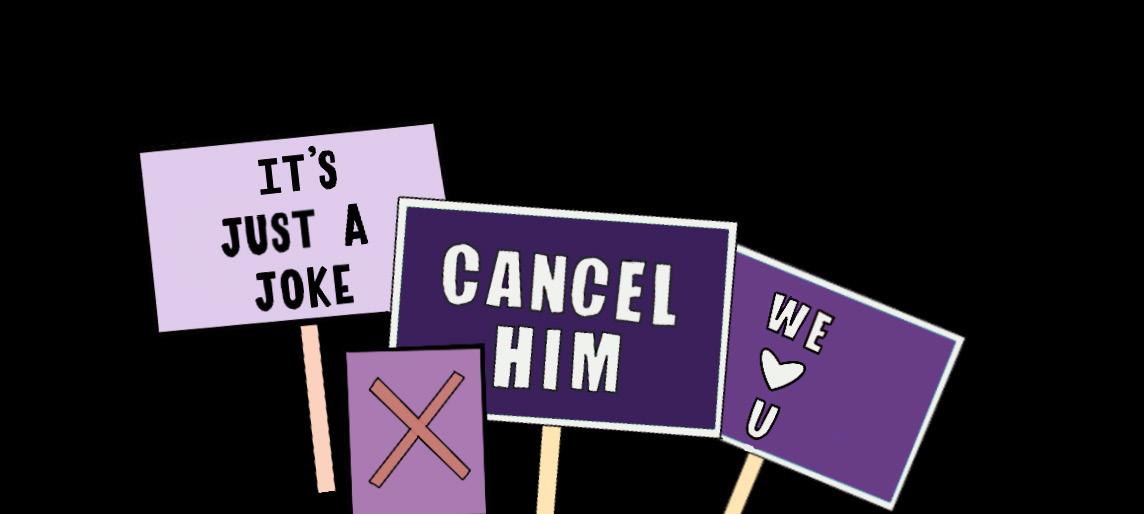
the comedian. This can even take the form of simply not laughing at a joke. After all, death threats and slurs will often result in nothing but an eye roll or getting blocked, and may even embolden them to integrate even more extreme views into their jokes and sets.
“If my brother told a joke that I thought was insensitive or racist, I wouldn’t react. I’d say ‘That’s not funny, try again,’” Spanish teacher Michael Esquivel said. “If you’re a comedian, that means you’re constantly working on your craft.”
Often, the fine line between constructive criticism and cancel culture is hard to detect, as cancel culture is argued to both be someone’s free speech and while having the potential to harm the speech of others. Regardless, it’s good to set groundwork towards informative comments, rather than ones that immobilize comedians from speaking entirely.
“Extreme cancel culture is a dangerous road to go down,” librarian Amy Ashworth said. “If you look hard enough you will eventually find dirt on everyone.”
Although the appeal for many people coming to comedy shows is to listen to unfiltered dialogue, it doesn't take away from the responsibilities comedians hold as public figures. ecause of accessible and engaging storytelling comedians produce, consumers are more likely to internalize the message being said. Especially when a comedian is talking about groups that they aren’t a part of — they should be more open to taking feedback, instead of labeling people offended snowflakes or overly sensitive.
05 OPINION May 8, 2023
GRAPHIC ILLUSTRATION BY ALYSSA WANG AND SURYA SARAF
BY RIKI MURASE
Dave Chappelle famo s ome ian ame n er re for his transpho i omments hi h ha e sparke a k ash from m tip e omm nities



Welcome. Salut. Khush. Bienvenido.
Amdeed. Huānyíng. While these phrases extend a warm invitation, the various tonal changes in each language pressure the brain to perceive them differently. Thus, discrepancies in accents and tone switches often give rise to stereotypes, which can have far-reaching effects on both a regional and global scale.
Roman emperor Charles V declared, “I speak Spanish to God, Italian to women, French to men and German to my horse.” Although not as blunt, the conception of “romantic” versus “ugly” languages continue to prevail. Sociolinguistic studies have observed that the allure of a language is determined by how positively one views a community. In its most simple form, this phenomenon is evident in history and international affairs, where language perception is altered by former expectations. For example, when listening to German, one may often misconstrue syllables as harsh or commanding.
“Particularly, cultures that have languages that
don’t use a lot of tones tend to find tonal languages almost like gibberish because they’re missing so much,” English teacher David Clarke said. “‘People who speak in Cantonese, they always sound like they’re arguing,’ is what the kids will say. It has to do with both stereotypes about the culture being imposed upon the language and the language itself.”
Language value is often linked to the prestige of the speaker — the increasing popularity of Chinese as a global language is linked to the country’s major economic growth; conversely, languages spoken by a less economically powerful group may not be seen in the same positive light.
Linguistic stereotypes are even pertinent in lighthearted children’s media. In “The Lion King,” king Mufasa has an American accent while Scar, the villain, dons a British one. Furthermore, Dr. Doofenshmirtz, nemesis of Perry the Platypus in “Phineas and Ferb,” has a German accent and often references the culture. The use of German, Eastern European and Russian accents for animated villains in Western movies is likely a reflection of the U.S.’s hostility toward these countries during World War II and the Cold War. In one study done by sociolinguist Calvin Gidney, which analyzed random samples of television shows, a majority of heroic characters were American-sounding. By symbolizing defeat of a foreign threat by an American hero merely through accents, American media places the U.S. on a pedestal for younger audiences as they are developing views of the world.
“As long as the media fed to our children perpetuates these harmful stereotypes, the next generation will continue to contribute to negative ideas surrounding specific groups,” Intersections club president Vineeta Muvvala said. “It’s up to us to change the narrative and promote a more inclusive future, starting with television.”
The language processing center of the brain attempts to form patterns out of foreign stimuli. When responding to words or sounds that cannot be interpreted, it resorts to a more basic understanding based on tone. As such, guttural and more consonant-based languages are taken to be brash or
BY SRUTHI MEDEPALLI AND SAMIYA ANWAR
harmful, while more harmonic and vowel-heavy languages are perceived as more sophisticated or advanced. Languages like Mandarin consist of many tonal changes, whereas those such as French are relatively smooth-sounding. While this doesn’t impact native speakers, these shifts in tone or lack thereof influence how foreigners view various cultures. Arabic, one of the most frequently misunderstood languages and difficult to learn, is spoken throughout the Middle East. The center of much political conflict and controversy, confusion surrounding Middle Eastern politics can be compounded by views of the languages spoken there.

“As a mixed person, people are often surprised that I speak Spanish,” junior Peter Agguire said. “Especially with my parents, I do feel my family is treated somewhat differently when we’re speaking our native language instead of English in public.”
Even within the U.S, the wide variety of ways to speak English create preconceived notions about certain geographical areas. Discrepancies between the timing and rhythms of southern English dialects in comparison to northern speech styles have contributed toward beliefs about the competency of residents in these regions. Southern “drawl” or “twang” is characterized by slower syllables and exaggeration, which can become associated with struggling to properly comprehend English, form words or think

Harsh opinions concerning the culture and language of certain groups typically bounce off each other. The South’s historical resistance to change and focus on traditional values has also contributed to slow-paced ideas of the South. In another example, stereotypes placed on African American Vernacular English judge the language for its colloquial tone and increased number of contractions or slang. The extent to which linguistic stereotypes are based on culture, or that cultural stereotypes are linked to language, remain hazy. Of 201 Lynbrook students polled, 87.5% agreed that stereotypes could be formed based on their
“People tend to think of those speaking Southern dialect as being ignorant because they take longer to say things,” Clarke said. “But that’s also an effect of the juxtaposition between that accent versus what you might call a common, stereotypical, newscaster English.”
As the world becomes increasingly global due to connections from social media and the Internet, language will adapt to change. Phrases across the world have begun to insert themselves into American English. Yet, stereotypes concerning specific vernacular and accents continue dividing people, and whether they will persist remains unknown.
07 the Epic CENTERSPREAD
G R A P H I C I L L U S T R A T I O S B Y C A T H E R I N E ZHOU
Many languages may be speaking their last words
BY ANUSHKA ANAND AND APURVA KRISHNAMURTHY
As English continues to globalize and be prioritized over other languages, language isolates are left behind. Many communities lose a part of their culture as younger generations forfeit a link to their heritage and identity.

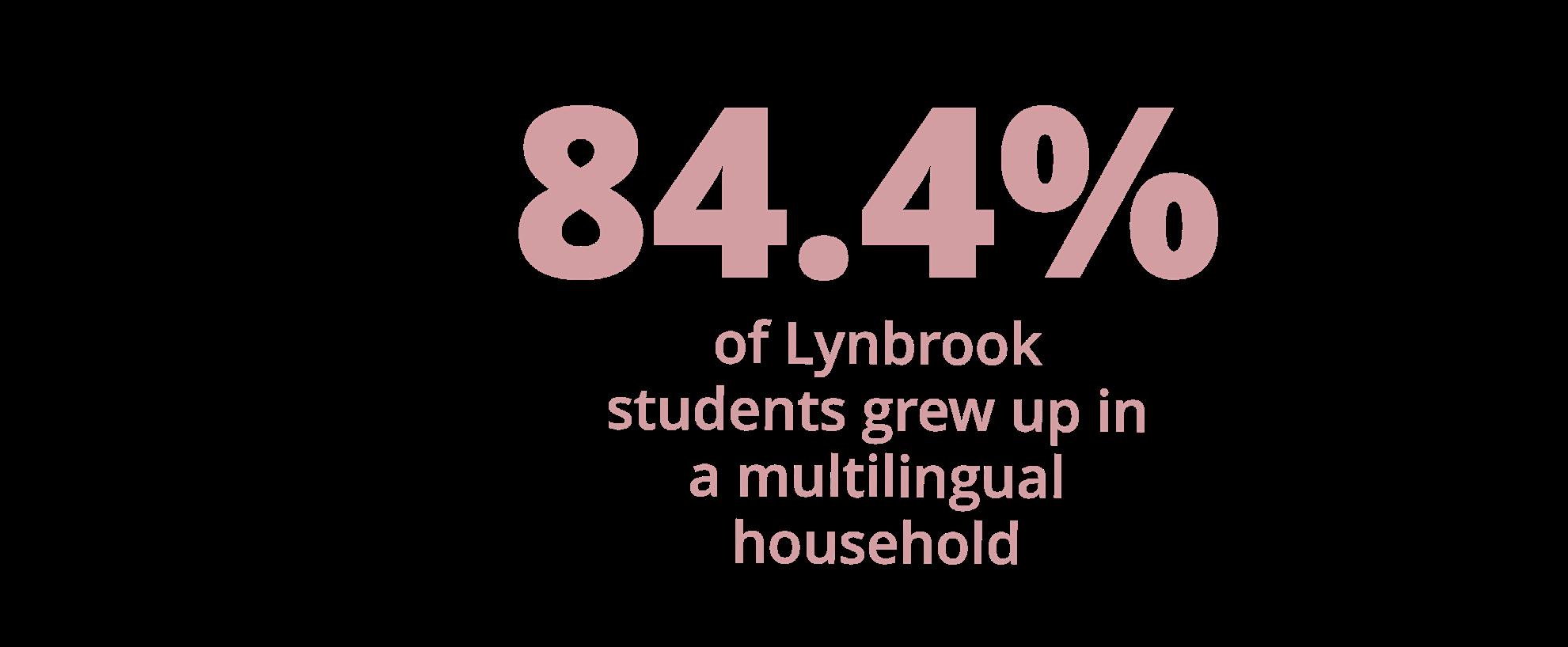
“Languages tell you about culture and act as the memory of older generations,” freshman and Shanghainese speaker Cindy Tao said.
There are over 7,000 recorded languages spoken in the world today, about 35% of them being endangered. A language dies when its last known speaker dies. According to the Language Conservancy, nine languages die every year.
Some languages die out quickly when small communities are wiped out by disasters. El Salvadoran speakers of the indigenous Lenca and Cacaopera languages abandoned their languages to avoid being identified as natives after a widespread massacre in 1932. The Dunser language of the Papua region in Indonesia has only a handful of remaining speakers after flooding in devastated the Dusner village.
“The Cherokee tribe had a written language which was wiped out in an attempt to Americanize,” Clark said.
In the digitalized age, online or televised content tends to cater to society’s most prominent languages. Children in multilingual homes are often exposed to the most dominant language media from their area, making them more accustomed to the dominant languages during a crucial age of language development. As this content does not favor indigenous languages, populations lose familiarity with them, especially with the most integral parts such as colloquialisms, making it harder to pick up native languages later.
Colonialism is one of the leading causes of linguistic endangerment in areas with large indigenous populations. Historical emphasis on assimilation and suppression of indigenous languages promoted attitudes of cultural superiority, as proficiency in uropean languages was viewed as prestigious and could further oneself in a colonized society.
With the globalization of English came English schools, using styles of instruction in English throughout Asia and non-English speaking European countries. Younger generations begin to lose proficiency in their native dialects as nglish is placed at a higher importance. “Historically, languages have really been a political issue because they’re such a powerful tool,” Clark said.

Immigrants often prioritize learning English to bring more economic success to future generations.
Many second-generation U.S. immigrants do not speak their native language fluently because it is more economically and culturally beneficial to speak English. However, elderly speakers of a language are often left behind in rural communities, holding on to the fleeting traces of the language as others begin to forget it.

“It’s sad because we can see languages disappearing for newer generations,” Tao said.
Preservationists have been working to revive endangered languages as these languages are closely linked with regional or ethnic identity. For instance, Hebrew died out as a colloquial language in the 2nd century but was revived in the 19th-20th century. The language was continued through religious mediums as well as used in scholarships causing it to come back in prevalence. ow, it is the first language for many in Jewish countries.
Languages that are considered “dead language” are often commonplace within academia. Many high schools and higher education institutions offer classical languages such as Latin, Greek and Sanskrit despite the former two not having any native speakers. The efforts have proven influential in reinvigorating these languages as there are roughly 25,000 native Sanskrit speakers and such education promotes the culture and furthers the language into future generations.
Preserving languages maintains longstanding cultures. Spoken words are linked with values and traditions which can be passed down through generations, which enable speakers to connect with older generations. As speaking languages connect a person to their nation’s history, it also gives the speaker a sense of personal identity. When languages are lost, a part of a culture is lost.
“You lose the language, the history and an understanding of the people,” Clark said. “Then the whole world just becomes too homogenized. The diversity makes a richer world.”
lost
 BY ASHLEY HUANG
BY ASHLEY HUANG
“Tsundoku” of ambitiously unread.
word holds Japanese precisely translated untranslatable The hazy diction stifle fluent and complete appreciation works.
“A huge fraction is context,” UC Literature professor as you translate, phrase into a new changes, the connotation
Attempting is undoubtedly literature unavoidable Dramatic differences each language and readers alike. definition, connotation, value in its original at least one of sacrificed to preserve choose what
Of the equivalent environmental
pride cultural
homology when
“Language Athreya
Language
GRAPHIC ILLUSTRATIONS BY VALERIE SHU
According to a survey of 202 Lynbrook students
Bilingual or bye-lingual?
range from improved cognitive function to enhanced cultural understanding and global communication. As such, the pursuit of linguistic mastery is a worthwhile endeavor, regardless of an individual’s age or background. Lynbrook students and teachers have embraced the benefits of learning a new language.
Spanish Sophomore Paula Begonia immigrated from Venezuela to California in 2021. As a native Spanish speaker of 16 years, she faces her own set of challenges when fusing two languages into her day-to-day life. At times, she struggles to navigate her own identity when trying to adapt to communicating with different people.
“It was hard to feel like I was a part of something because there’s not a lot of Hispanic people here at school,” Begonia said. “Sometimes I feel like I’m translating a word that I know the meaning of but just can’t find the written word. eople make comments about my pronunciation. It’s sad because they usually don’t know about all the effort others are putting in.”
French French teacher Denise Schang exemplifies how learning a language goes beyond putting words and grammar together.
“I always tell my students not to stress over pronunciation or making mistakes, because at the end of the day, what’s most important is for one to understand the culture,” Schang said. “What’s great about learning a new language is that you challenge your own thoughts and broaden your perspective.”
She cultivates a deeper understanding of French among her students.
“Instead of limiting another person to just their accent, recognize this person is being exposed to two cultures as there is so much to learn from each other,” Schang said.
Chinese
Until 2015, sophomore Riley Dowdell attended an international school in Shanghai before moving to California. At this school, he spoke English with the rest of the students, who all came from different countries all over the world. Within eight years, he picked up parts of the Chinese language by taking classes everyday at school.
Despite forgetting much of the Chinese language, he remembers the customs and cultures that were exhibited in his International school.
“We had uniforms so it was a cultural shock for me when I went to the states,” Dowdell said. Their cafeteria food was definitely much better in China and classes were a lot stricter.”
Japanese
When Jeremy Kitchen was in high school, he was enthusiastic to leave his hometown and travel somewhere new and exciting. Due to the influences from his Korean friend, he decided on South Korea as his destination. After finding out the option was unavailable, Kitchen found himself in Japan, which opened up a new chapter in his life.
Kitchen can often relate to his students and understand their struggles when learning the language.
“We actually have a mistake counter in my classroom where my students keep track of my mistakes, and it really helps me realize that while I am teaching my students, I am also learning along with them.”
lost in translation
Words aren’t enough: exploring limits of translation
sundoku” is the Japanese word that describes the habit ambitiously buying books but letting them pile up unread. Uniquely expressed only by this language, the Japanese cultural connotations that are unable to be translated to other languages. Likewise are multitudes of untranslatable words isolated by linguistic and semantic barriers. diction of translated text is often left unnoticed and can and authentic communication or appreciation of secondary literary fraction of how text communicates UC Davis English and Comparative professor Joshua Clover said. “As soon translate, you’re moving the word or new context. As soon as the context connotation gets really difficult to
characters. “井底之蛙” (jǐng dǐ h w is a well-known idiom used to criticize someone with a closed mind. Direct translations render this phrase as “frog in the bottom of a well,” disregarding all meaning and context. erely examining its definition and translation, one would be unaware of the fable from which the idiom emerged from a large aspect of its aesthetic value. Sacrificing any of its general features may debilitate the original beauty and message of Chinese literature.
“Untranslatability often comes from deep-seated cultural meaning that is understood by everybody in the culture where it originates, but otherwise has to be explained at some length in a paraphrase,” Stanford University Comparative Literature Professor Roland Greene said.
Would you rather read literature in its original language or the language you are most familiar with?
language is uniquely influenced by their own environmental factors, so none can convey direct translations for Inuit snow vocabulary, as these words are only central to Inuit daily life.

“Of course, it’s possible for the English language to create words with the exact same denotations and connotations as words from other languages,” Zhuang said. “But the spread of new words from a niche creation into everyday use is very much a culturally contingent matter — oftentimes there won’t be enough people using the word for it to be embedded into the common English vocabulary.”
To mitigate the inevitable impact of translation in literary works, some languages have adopted words or phrases from others to preserve linguistic and semantic authenticity. “Déjà vu,” a familiar French term used to describe the feeling of having already experienced a current situation, is frequently used across different cultures. By using the French term, people are able to evoke the term’s concept without having to lose connotation or conciseness.
66.5% (121 votes)
to understand every language undoubtedly impossible, making translated unavoidable and crucial to education. differences in cultures and tones of pose challenges to both translators alike. Each word holds a unique connotation, allusion and aesthetic original language — when translated, of these formal features must be preserve another. Translators must to sacrifice, while readers must fill in the blanks. the most common factors that interrupt precisely equivalent translations are cultural, historical, linguistic and environmental differences.
“Language is the backbone of a culture,” sophomore Athreya Iyer said. “Language not only serves as a source of pride for cultures, but it also serves as a way through which cultural folktales are passed down through generations.”
Language is culture and culture is language; the homology between the two creates distortion in one when the other is removed. Chinese idioms that remain frequent in daily conversation strongly represent this concept; they originate from classical Chinese fables — each idiom retells its respective fable in often four concise


33.5% (61 votes)

Direct translations may also erase historical context. “Whakapapa,” a word in ori, most commonly spoken in ew Zealand, encompasses the idea that people are connected to their ancestors and the land they come from. In ori history, natives have used whakapapa to trace their ancestral connections, allowing them to assert their rig`hts and claims to land. This word is not only deeply rooted in the history of New Zealand but is also important to Maori identity and culture.
Linguistic differences can also challenge precise translations between languages; one example can be shown by comparing possession in English and French. The English language uses possessive nouns, while the French language uses passive voice to show possession. For example, an English speaker may say “the cat’s collar,” while a French speaker may say, “le collier du chat,” which directly translates to “the collar of the cat.” The lack of possessive contractions in French makes French text almost always longer than English text. French possession represents just one of many languagespecific grammatical rules that pose challenges to translators.

Environmental factors may also contribute to the lack of direct translations between languages. The vocabulary of Inuktitut — a language most commonly spoken throughout colder countries such as northern Alaska, Canada and Greenland — encompasses many words used to describe different types of snow. A few examples include: “ ” qanik , meaning fresh, falling snow; ” aput , meaning soft, powdery snow; and ” pukak , meaning snow with a layer of ice on top. Each

“Nothing has a perfect translation,” Clover said. “It’s more important to feel the experience that the writer and translator are both constructing, rather than focusing on understanding everything. The experience encapsulates both meaning and emotion.”
Because literary works are published in a limited number of languages due to accessibility, translations are thus valuable for providing analysis for education. Nonetheless, due to the loss of authenticity, translations may not precisely convey the same meaning as original pieces.
To address this phenomenon, many of Lynbrook’s literature teachers incorporate short lessons and research projects before beginning reading units to immerse students into the cultural and historical context of the literary pieces. This allows for more efficient analysis and helps students better understand the author’s intent and message behind particular details in the book.
HUANG AND SUSANNA TANG
Original
Translated
snow
WTF?! The origins of swear words
BY MEERA NAMBIAR AND SURYA SARAF
They say a single “F—ck!” is worth a thousand words — a profane but clear cry of frustration, or a little emphasis to everyday conversation that holds a potency in its resounding four letters. Swear words permeate our lives as forms of self expression, cathartic cries and bitter insults. But from where do these deep-rooted exclamations come?
Swear words have convoluted origins. In terms of etymology, today’s American swear words have roots in German, Dutch and Middle English, sporadically developing from historical phenomena or by random occurrence. For instance, the word “crap” was supposedly familiarized after sanitary engineer Thomas Crapper developed lavatorial innovations in the late 1800s. However, the practice of swearing shares the intention to express oneself in ways that ordinary words simply cannot do, and in doing so, its power lives on.
“Swearing is a way to strongly express oneself in a fairly harmless way,” English teacher Anna Kirsh said.

A deep dive into etymology reveals the linguistic distinctions but emotional commonalities between each swear word. Swear words are typically short and punchy, which adds to their emotional impact, and most stem from taboo topics like sex and blasphemy. The F-word, the most common cuss word used by Americans today, has roots in Latin and Old German. Originally used to mean “to strike or penetrate” or engage in sexual intercourse, it became a widely accepted swear
saying “motherf—cker,” was popularized in Kurt Vonnegut’s Slaughterhouse Five, having originated from an 1898 Texas trial.



The timeless “sh—t,” of German and Dutch origin, having long meant “to poop,” serves now as an exclamation of frustration, though its original meaning is still widely used. The addition of “bull,” meaning “false talk,” was popularized in the mid-14th century. “Crap” has origins in Old Dutch farming language while “ass” started and is still used to mean donkey. Other forms of “Ass” in Old English include “arse” and “buttocks” — both have retained their meaning over time.




Swear words also hold similarities across languages. According to a study conducted by the Psychonomic Bulletin and Review, certain harsh sounds signified by phonetic letters “k”, “t and “p” are found in swear words across many languages. Other less aggressive sounds like “w”, “r”, and “l” are much less likely to be found in swearing.


Although swearing is widely considered taboo, it has a unique position in language — it is one of the most powerful and persuasive ways of communicating with others. Some studies have found that swearing leads to a higher pain tolerance. It also has positive effects in social groups, often seen as a sign of a friendship and trustworthiness.
“Swearing is healthy to use at times, especially with your friends when you’re joking around because it shows you’re not being too serious,” senior Maïa Bline said. “You might be tempted to please a lot of people and speak in a certain way, but it’s good to let out your feelings sometimes. And I think swearing is a good way to do that.”
It is important to note that some aspects of swearing have roots in racist, sexist culture, creating a fine line between swear words and slurs. Slurs, intended to insult and damage one’s reputation, often used against specific racial, ethnic and
Emojis have slid into your DMs

LOL: Lots Of Love or Laugh Out Loud? Is the emoji with two palms clapsed used to clap or to pray? In the age of rapid communication via cell phones, texts with abbreviations, shortened words and emojis convey thoughts with less effort and less characters. Texting has taken over the world as the fastest method of communication, a new language for younger generations.
Short essage Service, the first form of texting in cell phones, was the pioneer of sending short messages quickly from one phone to another. Shorter than a proper email, quick communication over text has become the tool for people with busy lives.
Originally limited to 160 characters, SMS users needed to pack whole sentences into a couple of phrases, which eventually gave way to an essentially new type of language, nowadays known as textism or textese.
“When I started using Instagram and social media, abbreviations were quite new to me,” sophomore Vrishank Chandrasekhar said. “But after a while, it’s easier to understand.”
To send messages quicker, run-on sentences and lack of punctuation are forgiven as long as the receiver understands the message like spoken conversation. Common trends include replacing entire words with one letter and acronyms for common phrases, though meanings may be confused through short and abbreviated messages.
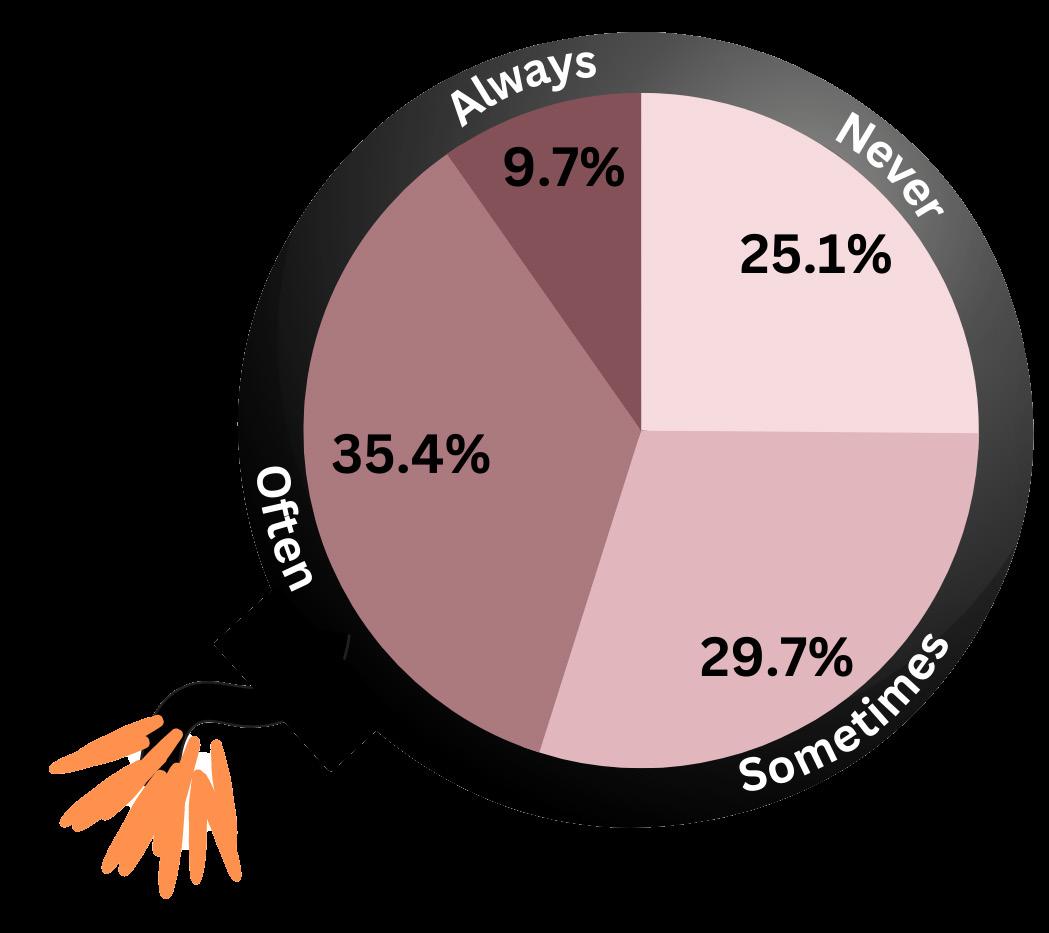

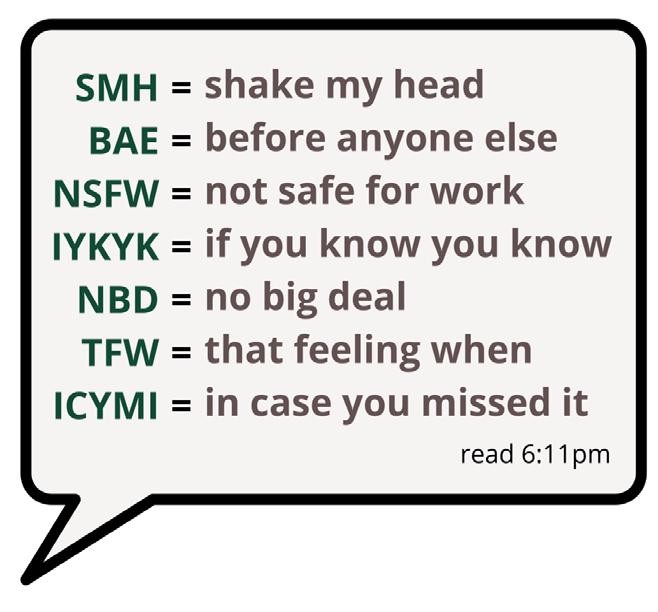

“If it’s a more serious topic, and I accidently put an exclamation, it just sounds kind of off,” senior Teresa Chen said. “My friends might be a little confused, but I think they understand it anyway.”

How often do you swear?

gender groups, differ from swearing in their connotation. Words like “c—nt” and “sl—t” are rooted in antiquated views of women as promiscuous and contemptible. “B— tch” can be seen as both a slur and a swear word depending on the audience, rooted in misogyny, and used to refer to women who rebel against societal norms. Many women, however, have reclaimed such terms to signify a compliment or form of empowerment for other women, an example of how the culture of the present shapes views of swearing. Slurs such as the n-word, which were more commonplace in the past, are now widely seen as derogatory due to changes and increased awareness in societal standards. The current generation is increasingly well informed about racial prejudice and discrimination, and open minded in terms of accepting different cultures and treating them equally.

It’s no question that swearing is complicated. Its ethics, origination and intention are not only crudely defined but also constantly changing. The present culture has its own rules for the use of slurs and swear words, yet their precedent for use is never fixed. Regardless, these short and punchy terms are ingrained in the English language — their capacity for use is ultimately up to the speaker.
As convenient as texting is, short messages are often misunderstood; the same message with varied wording or acronyms can completely change how it’s perceived. With the increased usage of texting within younger generations, it is important to separate and distinguish conventions for both formal English and casual texting.

“Sometimes I do use abbreviations in real life too, like ‘BRB’ or ‘ILY,’ ”Elangovan said. “It’s easier to say and just sneaks into normal English.”
While textism can occasionally slip into formal English, textism can exist as a language in addition to English — a separate set of words that people communicate in.
Developed by cell phone developer and artist Shigetaka Kurita in the late 1990s, emojis further helped texters save characters in messages by depicting emotions, symbols and ideas in small images. Since then, emojis have evolved to become an essential part of communication and internet culture.




“When it comes to texting, words are really just words,” Chandraeskhar said. “There’s not much tone compared to emojis or sending a random video of yourself crying.”

Having multiple unique uses is part of the criteria for a new emoji, though it may lead to misunderstandings of the emoji’s meanings.


“Some people don’t use emojis because they think it’s extra,” senior Sruti Elangovan said. “If you’re texting you can’t really convey the same tone as actual speech, so if it’s light hearted, you might as well just add an emoji to show that.”

May 08, 2023 CENTERSPREAD 10
I text with emojis... $%!&*! %!*&#! $^!$#@! %!*&#! &$#%! PAGE BY SOPHIE AU
The camera is set up. The lighting is perfect. And… action!
While watching Youtube videos is an entertaining pastime, for sophomore Colin Chow and juniors Haley Tamtoro and Adithri Sharmi, creating their own content is even more gratifying.



Chow started his Youtube channel, Coin Cow, while bored during quarantine. While he’s always imagined being a outuber, he derived inspiration to finally fulfill his dream from the TikToks and consistent creators that kept him entertained from childhood to his time in isolation. Chow began by posting snippets of his life, from adventures with his friends to basic school work. Tamtoro’s vlogger roots also originated with quarantine, when she grew interested in lifestyle videos, and specifically, the artistic videography her favorite creators used. What began as a simple obsession with popular Youtubers led to an exploration of video production, opening her horizons to playing around with exposure and framing cinematic clips. She joined Youtube under the name heyyelah, pledging to herself that she would make videos at least once a month for consistency.
“I wanted to make videos, but I had no kind of excuse to do so,” Tamtoro said. “Youtube holds me accountable.”
Singer Sharma expanded to Youtube after establishing herself on other platforms such as Instagram and TikTok.

For all three students, the process behind posting Youtube videos follows the same basic steps of planning, recording, editing and uploading. Nevertheless, each

has tailored the process to fit their own habits. Tamtoro primarily films on her phone for convenience and portability, while Chow uses a Canon camera for higher video quality. From production to editing, the completion of a video often requires advanced equipment and editing software. Chow and Tamtoro have invested both time and money into video production equipment, and are committed to producing high quality content.
Chow can spend anywhere from a couple of days to a week editing a video, painstakingly color grading, trimming and adding visual effects to his clips on Adobe Premiere Pro. Tamtoro spends roughly a week editing her videos, mainly during the night with LED lights the only source of brightness in her room, as she reserves the afternoons and evenings for homework and other school-related activities. osting consistent content on outube is a difficult task, especially during the school year and periods of creative burnout — when content creators lack inspiration to start a new project. For Chow, Youtube is more of a hobby, a passion project and not a priority, so he mostly works on videos when he feels a creative itch. e aims to find a balance between Youtube and his other pursuits, especially by producing a mix of more labor-intensive, longer videos and shorter videos.
“Youtube helped me realize that even the littlest moments in my life, no matter how many views that they received, are worth remembering,” Tamtoro said. “Moving forward, I hope to continue learning more about video production so I can document my experiences with greater creativity.”
Lynbrook youtubers you should subscribe to
BY SARAH ZHANG
11 the Epic FEATURES
Up next FINALS WEEK study grind, presentations + fnals A Day in the Life of Colin Chow Cruel Summer (Taylor Swift) cover 611 subscribers Subscribe @heyyelah @colinchow_ @adithrimusic GRAPHIC DESIGN BY LARRY WANG PHOTOS BY KATIE CHIN 114 views 1.2K views 170 views
Peer Court: for the students, by the students
 BY TANIKA ANBU
BY TANIKA ANBU
Rather than sentencing a student to uvenile court in the case of misdemeanors, the Santa Clara County eer Court program helps to break the school-to-prison pipeline by allowing students to share their story and receive a genuine chance for improvement. eer Court, run by students, trains students to act as attorneys and represent students who have broken California State ducation Codes, such as those concerning drug use and student initiated violence. Student attorneys put together their case by interviewing the client and performing statements to a udge that evaluates the outcome of the student. Instead of real sentences, students are instead instructed to write apology letters or receive counseling.
ynbrook

Su joined Peer Court to help the community and apply what she has been practicing in her school’s Mock Trial team to real cases. In Mock Trial, Su developed a strong understanding of courtroom procedures and has honed her skills as an attorney by participating in numerous scrimmages and competitions that have prepared her to present herself in court.

“I am excited to use my legal knowledge and public speaking skills from Mock Trial in real life applications,” Su said.
Su is dedicated to becoming an attorney and will be taking on her own cases once she
Su are avid participants in eer Court and work to help students receive second chances.
practices Peer Court procedures.
very new member of eer Court is guided through training led by the program’s advisor and is educated on the school-toprison pipeline. Su attended a dedicated attorney training where she learned about the acceptable rules of evidence, common cases and speeches. While Mock Trial is more analogous to a fast-paced debate competition, Peer Court emphasizes fairness and restorative measures. umani ing the student offender is one of the main goals of Peer Court.
“We try to help students change behaviors, not punish them. This helps to redirect a life path that might eventually lead to prison,” Su said.
Since 7th grade, Chikkareddy has acted as an attorney in the Peer Court program, successfully arguing several cases ranging from vandalism and school fights. Driven by her passion for community service and desire to help others, Chikkareddy uses her skills to advocate for her clients in eer Court. When interviewing her clients, she makes sure to give them space and ask them thoughtful questions so she can develop strong examinations and speeches. She appreciates Peer Court’s mission of helping students in a more restorative way and typically recommends counseling, community service and apology letters to the students she works with.
y providing these sorts of alternatives to traditional punitive measures, students aren't pushed out of school and into the criminal justice system,” Chikkareddy said.
In one of her most difficult cases, she only received the facts an hour before trial, as it was being decided whether
the student should even report to eer Court or if they should be presented with immediate expulsion. Chikkareddy helped prevent the student from being expelled or going to uvenile court.
Chikkareddy has learned that cases are never about winning or losing, but instead, about helping the student and their needs. She advises her clients to suggest anger management or community service when deciding on restorative interventions. Learning new tactics from the opposing counsel has also helped her grow as an attorney.
Yechan Lee marches his way into military academy

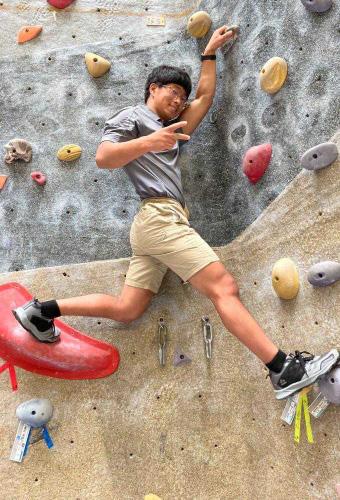 BY ALYSSA WANG
BY ALYSSA WANG
“Sound off! One! Two!” For senior Yechan Lee, this army chant will soon become a daily routine while attending the United States Military Academy in West Point, New York for the next four years. There, he plans to continue his studies in computer science while simultaneously preparing for his five years of mandatory service in the army, where he hopes to work as a cyber operations officer.
The United States Military Academy, also referred to as S A or West oint, is a prestigious institution providing a rigorous education to cadets and preparing them to become officers in the nited States Army. The student life at USMA is unique as each cadet must learn to balance academic studies with military training and physical fitness requirements.
Before applications began, Lee was skeptical about applying to a military academy despite his mom’s efforts to convince him that his leadership qualities and participation in wrestling and band would make him a good fit for West oint. e eventually decided to attend a week-long summer program at the academy to learn more about life at West oint. veryday, he woke up at 5 a.m. for an hour-long workout and informational meetings about the academy. In addition to being free, with housing and materials all provided for each cadet, S A emphasi es physical fitness ,which ee believes is necessary to maintain good health and enforce discipline. The academy also focuses on maintaining character by implementing its strict honor code — a cadet will not lie, cheat, steal or tolerate those who do.
There is definitely a lot of discipline involved,” ee said. Their way of teaching makes me feel that everyone who is there is taught to be honorable and the best person they can be, and that is the biggest part that drew me in.”
In June of 2022, Lee began the long application process, which included various requirements such as recommendation letters, supplemental essays, a nomination from a congressman or senator and a physical assessment, as mandated by the USMA application. During his week-long stay at the USMA, he was unsuccessful in passing the physical assessment. So, he attended a summer wrestling camp in Los Gatos and continued training throughout the school year to improve before the official administration. Meanwhile, he applied for the nomination from both of California’s senators, Senator Feinstein and Senator Padilla, as well as Congressman Ro Khanna. In late December, Lee was informed that he received a nomination from einstein after two interviews with einstein and hanna.

“That was such an accomplished moment because without that nomination, there is no chance of getting accepted into any service academy,” ee said. The interview offers from Congressman Ro Khanna and Senator Feinstein were huge opportunities, and I am grateful that Senator Feinstein chose to nominate me for the academy.”
As he prepares to join USMA next year, Lee is excited about meeting new people and improving as a leader and a person, anticipating the connections and memories that he will make with his fellow cadets. After he graduates from the academy in 2028, Lee will oin the army for his five years of mandatory service. During his service, he hopes to implement the lessons he has learned at West oint and fight for his country and something bigger than himself.
It is definitely going to be hard,” ee said. There are going to be some points where I wonder why I chose this life. owever, I know at the end of the road, it is going to make me a better person and I know I will not regret it."
May 8, 2023 FEATURES 12
uniors Aishani Chikkaredy and yrsten
PHOTOS USED WITH PERMISSION FROM YECHAN LEE
PHOTOS BY KATIE CHIN GRAPHIC ILLUSTRATION BY SAMIYA ANWAR AND AUDREY SUN
By providing alternatives, students aren't pushed out of school and into the criminal justice system.
Aishani Chikkareddy, Junior
We try to help students change behaviors, not punish them. This helps to redirect a life path that might eventually lead to prison.
Kyrsten Su, Junior
BY SAMYUKTA SARMA AND MAPLE LEUNG
Strutting down runways, singing and dancing to captivating music while advocating for charitable causes, drag artists foster a culture of their own. Whether it be the early English Shakespeare plays of the 1500s or recent involvement of drag in political policies, the art form boasts a rich cultural history.
Drag — the art of dressing up in hypermasculine or hyperfeminine clothing and makeup — has risen in popularity through social media apps TikTok and Instagram, which have introduced the art to mainstream popular culture. Now, drag is typically seen as a form of entertainment as artists perform comedy, singing, dancing or lip-syncing, however, a number of drag artists have opted away from performing at all, serving as figures in their respective communities. Over time, the art of drag has evolved and adapted to fit the needs and desires of each generation.
“Drag has been around since the beginning as one of the earliest forms of self-expression for LGBTQ+ people,” said Gender and Sexuality Alliance club officer Spencer ppstein. It s precedent for all of queer history for the most part, and it s also very important today.”
The origins of drag can be traced back to the ancient Greeks and Romans, around 240 B.C., when performers in plays wore masks and exaggerated costumes. Due to societal norms, men typically played both male and female roles, distinguished by excessive portrayal of feminine features.
During the 16th and 17th centuries, men often played “trouser roles” in plays, by explicitly playing female roles during Shakespearean plays with voluminous skirts and corsets. Historians believe that one possible origin of the word is from how the dresses and petticoats would drag” along the stage floor, or that it once was an acronym for “Dress as a Girl”.

During the 1900s, drag had a heavy influence on audeville performers a form of live entertainment consisting of comedians, musicians and magicians who traveled across the nation to perform in a variety of theater shows. Specifically in the s, the number of drag shows spiked across America, as an illegal form of entertainment within speakeasies during the Prohibition Era. During the Harlem Renaissance, drag ball culture was not only popular among the LGBTQ+ community, but also attracted many straight, artistic and curious audiences.
In later decades, the popularity of these balls spread among the gay community and became a safe space for gay men to gather. To mainstream society, it was deemed illegal and immoral, yet despite this, these balls would continue to occur and became a crucial aspect in maintaining LGBTQ+ culture. They created a welcoming environment, where members of the community could connect with one another. Additionally, they helped establish and define queer culture well into the decade and gave many the chance to explore their sexual and gender identity or expression.
“A lot of the time, when we think of gay people, drag queens are included,” Eppstein said. “For many, drag offers a form of self expression that allows them to be how they truly are, without being judged by those around them. It also provides, for the most part, a very accepting community, if you can find the right part of it. It just makes you happy.”
Throughout the 1970s-80s, drag balls and culture increasingly integrated African American and Latino LGBTQ+ communities into the art, providing a safe
space for performers to showcase their skills and culture. Specifically, performers like Divine and RuPaul rose to fame by pushing the boundaries of what defined drag” and what was considered acceptable in mainstream culture.
Successful shows like u aul s Drag ace took the entertainment of drag a step further into the 21st century. Since then, drag has become much more mainstream, with drag performers of all genders and backgrounds being celebrated for their creativity, talent and individual ethnic cultures and styles.
Drag isn t restricted by gender or sexuality, because anyone can do it,” Eppstein said. “I think that a lot of performers use drag as a way to express their gender while still identifying as straight. Also, it s very entertaining, so it s kind of a bridge between the queer community and mainstream media.”
However, several conservative politicians have criticized drag as being immoral or inappropriate, seeking to restrict or ban drag performances within certain contexts. In 2018, the Bristol City Council in the U.K. faced intense backlash after it was revealed that the council had paid for a drag queen to read stories to children during library events. Protestors outside of the library eventually heavily disrupted the event, causing its discontinuation.
Similarly, in the U.S., controversy surrounding drag queen story hours has seen rightwing activists using rhetoric that these events promote “inappropriate content” to young children, with protests surrounding libraries and bookstores.
their public performances, arguably part of their right to freedom of speech.
“As the haters continue to show their faces in our government, on the news and social media, we must continue to show ours,” MORE! said.
As drag evolves to fit the needs of the community and inspire new generations of performers, LGTBQ+ rights and visibility continue to be debated political issues around the world. Drag remains a significant aspect of maintaining morale and pride for the LGBTQ+ community, fostering safe spaces for gender and sexual expression, serving community organizations and sharing success stories.
“Everyone needs to share their story with their friends, families, and allies; we need their voices,” MORE! said. “Tell everyone about your triumphs and struggles of being queer; this will hopefully trigger something in those who hate, as a simple reminder that we are all human and made of love.”
A drag queen and activist who was a prominent g re in the Stonewall Riots of 1969
Bobbie Minton
A drag king during the Harlem Renaissance who forged a path for Black people in queer spaces
“The rise in extreme anti-LGBTQIA+ hate rhetoric and the laws rapidly evolving around them across the United States from far-right extremists is ugly and unrelenting,” said Juanita MORE!, San Francisco-based drag queen and Absolute Empress 56 of the Imperial Council, the world s oldest G T nonprofit. Their message is poisonous and a sideshow to distract from more pressing issues.”
Criticism has sparked retaliation from drag performers, who argue that drag is an important and valuable form of self-expression crucial to the LGBTQ+ culture. Many performers continue to speak out against attempts to limit
Bianca Del Rio
Winner of the 6th season of RuPaul’s drag race, gaining recognition for her comedic style
Lypsinka
Lip-syncs to iconic songs lyrics and movie dialogue as a drag artist, showcasing the rise of entertainment in drag
ILLUSTRATION BY EILEEN ZHU
13 the Epic IN-DEPTH
Marsha P. Johnson
GRAPHIC
Addicted to the art of binge-watching
BY INAAYA YOUSEF AND VIDUSHI UPADHYAY
Sitting with laptop in hand and schoolbooks scattered about, the tedium of studying sets in and the allure of a brightly-lit screen and a beckoning etflix tab eventually proves too strong to resist. Binge-watching, or the act of watching multiple episodes or an entire season of a show in one sitting, has gained immense popularity in past years. Currently, around 70% of Americans say they binge-watch television shows. These numbers are worrisome to experts, as binge-watching can lead to unhealthy consequences such as issues with depression and sleep and the loss of a healthy lifestyle.
Binge-watching initially grew in popularity from 2011-2015, as streaming services such as etflix offered entire shows on demand for viewers to consume. The term binge-watching” was first coined in but it wasn t until 5 that binge-watch was named word of the year by the Collins English Dictionary. With the proliferation of streaming services, viewers have increasingly more opportunities to consume large quantities of content at once. Streaming services have definitely allowed for a lot of people to binge-watch more episodes at a time,” sophomore achana Dandamudi said. efore, on T channels, you had to wait for episodes to come out every week, but for etflix and other streaming services, they re all available for you right then and there so you can watch them without anything stopping you.”
Sitcoms like riends,” rooklyn ine- ine” and The Office,” with episodes usually running for - minutes, offer viewers a large amount of content in sectioned proportions, making them easier to consume in a single sitting. The result is an addictive and satisfying viewing experience for fans to fall into the ust one more episode” trap.
During CO ID- , living in isolation caused the percentage of people binge-watching to increase dramatically. Starting from March 14, 2020,
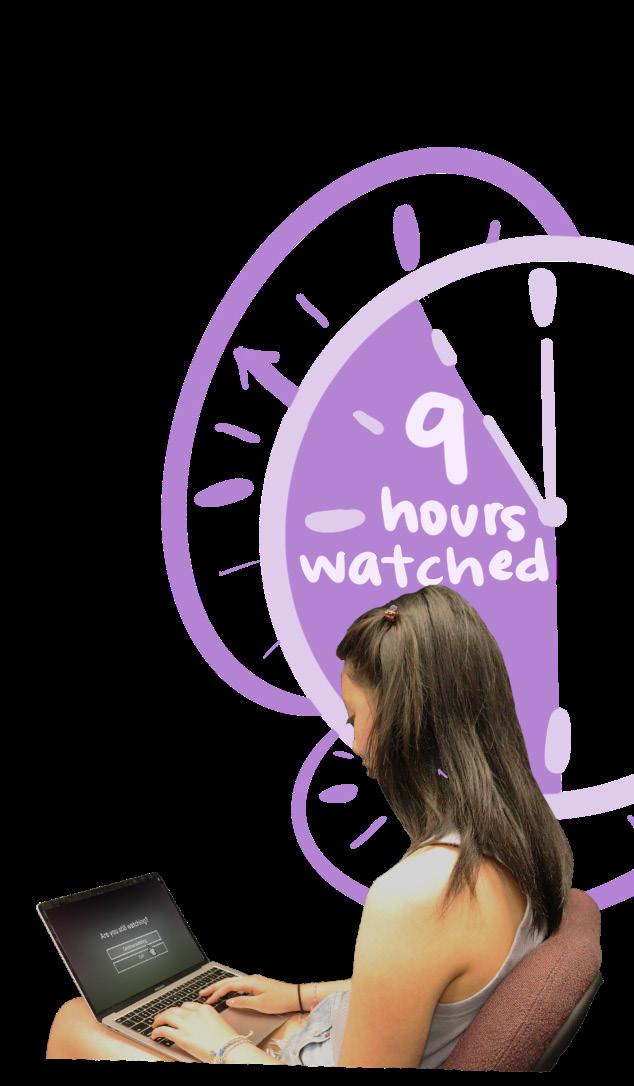
O ax observed a 5% increase in the number of subscribers who watched three or more episodes in one sitting. Other streaming services such as etflix and Ama on rime reported similar trends, creating and releasing more content in order to keep up with viewer demands. Streaming services make a lot of money out of people getting addicted to these shows,” said Grace strada, h.D., a full-time sychology faculty member and the Student earning Outcome Coordinator for vergreen alley College. Their algorithm is made to recommend more shows that viewers will like, so you re even more stuck.”
eople tend to binge-watch as it leaves them with a feeling of satisfaction and fulfillment due to the dopamine that is released during the activity. Satisfying one s desire for entertainment activates the part of the brain that provides a sense of accomplishment. With today s streaming services, there is no need for delayed gratification,” strada said. eople see no reason to wait to watch television shows, whether they are hoping to be the first to finish the episodes or are desperately trying to catch up to their friends and family.”
The addictive nature of binge-watching deteriorates attention spans. Unable to wait to consume media at their fingertips, binge-watchers have a constant craving to be entertained; thus, companies and streaming services feed on this addiction by creating episodes with cliffhangers, compelling the audience to continue watching. xperts have linked increased chances for cardiovascular disease, depression and sleep problems with binge-watching. Binge-watching results in heart problems as spending long periods in a sitting or reclined position while watching T reduces one s overall health and increases the risk of developing fatal diseases. any binge-watchers have been found to lead unhealthy lifestyles with a lack of exercise and a habit of binge eating which is directly linked to a weakened heart and increased vulnerability to sleep problems, blood clots and cognitive decline.
"But binge-watching can still be done in a healthy way," strada said. I en oy binge-watching with my family, and if it s done with others, you avoid isolation. Watching with others also increases accountability and eliminates the desperation to finish first or catch up to others.”
Feeling SAD? Blame the weather
BY CHELSEA LEE
Many people breathe a sigh of relief when the weather warms up and starts to feel like spring, but it may not bring as much relief to others. Illuminated on social media as seasonal depression” and formally known as seasonal affective disorder, this condition is related to changes in seasons. eople most commonly experience winter-onset SAD, but its other form is summer-onset SAD. oughly 5% of adults experience SAD for 40% of the year, according to the American sychiatric Association.
The symptoms seen in both types of SAD include losing interest in activities, feeling sluggish and thoughts of suicide. Winter depression” specifically has symptoms of oversleeping, greater carbohydrate cravings, weight gain and tiredness, whereas summer depression” may show as insomnia, poor appetite, weight loss, anxiety and increased irritability.


I once made it to the final round of a contest that involves a pre-scheduled interview, but because of my SAD, I didn t do anything for an entire week and did not find out until I finally checked my emails, but the interview already passed,” said sophomore li abeth Jiang. This made me reali e my experience isn t normal.”
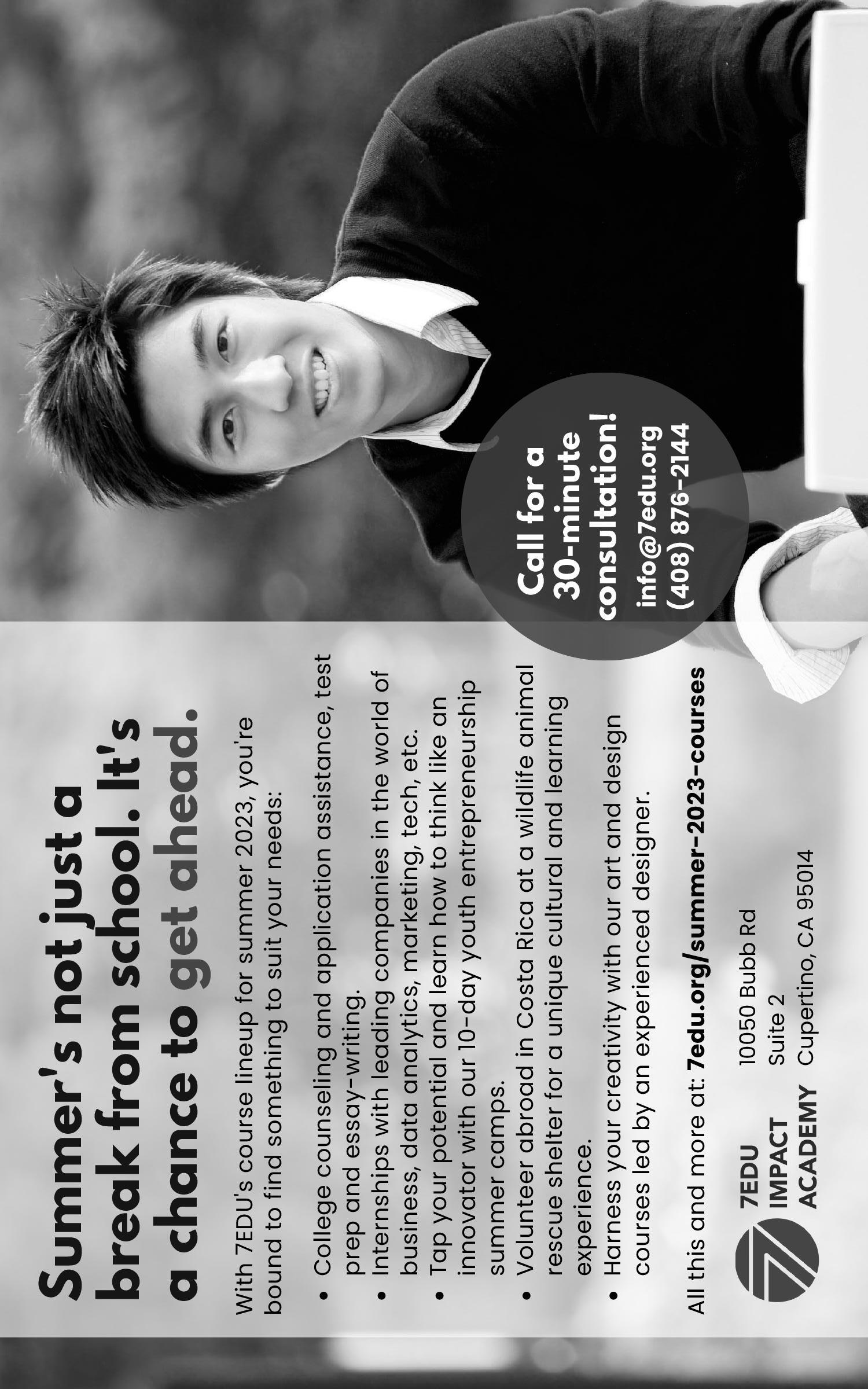
The symptoms of SAD generally improve on their own as the season changes but can be mitigated with a combination of antidepressant medications, communication-based counseling or light therapy. According to the A A, SAD is linked to the lack of sunlight
because of how progressively dark it would get,” S psychologist rittany Stevens said. or years, I had an office at ynbrook with no window. After we moved into the GSS building, I got an office with a window and became happier, probably because I had more exposure to natural light. It s unbelievable what a difference it makes for me.”
There is often a stigma around mental health conditions like SAD. Since there is no medical test to identify many mental health conditions, they are sometimes seen as illegitimate or more self-controllable” than other physiological conditions.

In our society, there s an expectation that people should ust be stronger than a feeling like grief, depression or anxiety that they should be able to ust power through that,” Stevens said. Whether it s in the brain or another organ, telling someone, don t be depressed or don t be anxious, is ust as insensitive and inaccurate as telling someone to power through any other body dysfunction.”
To create a more accepting community, Jiang expresses that respecting the needs of people with SAD can go a long way.
It s not like people with SAD want to be sad when the sky is gray, but the weather influences our mood a lot more than others,” Jiang said. Just being courteous can really help us feel understood.”
14 IN-DEPTH May 8, 2023
GRAPHIC ILLUSTRATIONS BY VIDUSHI UPADHYAY GRAPHIC ILLUSTRATION BY VIDUSHI UPADHYAY AND NEHA AYYER
New Biden proposal addresses transgender athletics
BY NICOLE GE
On April 6, the Biden Administration and the U.S. Department of Education proposed a rule that offers educational institutions a new framework for formulating eligibility standards for transgender studentathletes. The proposed policy allows schools to create their own policies while ensuring that all students have equal opportunities in sports. However, the new rule has ignited controversy regarding the extent to which transgender athletes should be allowed to participate in sports alongside cisgender girls and women.
The proposal requires universities and K-12 schools, who receive federal funding to take into account age, level of competition and the nature of a sport when developing policies that would prevent transgender student athletes from competing. For example, basketball and tennis may warrant different restrictions due to varying physical demands. Nevertheless, the proposal forbids outright bans against transgender athletes, allowing them to compete in sports depending on the school’s policies and discretion. The U.S. Department initiated the proposal to alleviate uncertainty surrounding the eligibility of transgender students in sports and to provide clarity for students, parents and coaches.

women. However, since August 2022, the NCAA has required athletes to meet required specific testosterone levels that vary by sport.
The ongoing debate regarding transgender athletes highlights the challenges of balancing inclusivity and fairness in sports. Some individuals are concerned that including transgender athletes in women’s sports may violate Title IX, which aims to promote equality and fairness in sports.

A key issue in this debate is whether transgender girls possess a testosteronebased advantage over cisgender girls, which could potentially undermine fair competition. If this is the case, it is argued that Title IX should be used to protect the rights of cisgender girls and women, and to ensure fairness in competition in sports.

“There is a biological difference between transgender women and cisgender women,” track and cross country runner Lily Fang said. “I believe the best way to have transgender athletes compete in sports is to create a new division for them.”
The proposal would prevent schools from targeting transgender athletes, but wouldn’t combat transphobia.
athletes do have an unfair advantage in competition. While some studies suggest that transgender women may have a performance advantage over cisgender women, other research has shown that hormone therapy and testosterone suppression, which has been implemented at the collegiate level, can significantly decrease muscle mass, bone density, and other physical characteristics,
schools to legally restrain transgender athletes from elite and collegiate sports through their enforced policies.
The proposal marks the first time the government has directly addressed this issue. This is an important first step toward finding a solution that balances fairness and inclusivity while protecting transgender students’ access to sports.
“My main opinion is that it’s not a good law,” Lynbrook Gender and Sexuality Alliance member Charlotta “Charlie” Dai said. “Although it would prevent schools from directly targeting transgender athletes, it would not have the effect needed to combat the rampant transphobia against transgender athletes.”
The National Collegiate Athletic Association has already made changes to rules regarding the eligibility of transgender female student-athletes to compete. In 2022, transgender women need to have taken a testosteronesuppressing treatment for a year before competing against other cisgender

This idea falls in line with the fairly recent ruling by the International Swimming Federation, which banned transgender women from competing in women’s events in June 2022. The ruling came three months after Lia Thomas, a transgender woman on the University of Pennsylvania’s swim team, won the NCAA Division I swimming championship in the 500-yard women’s freestyle, highlighting the issue of balancing equity and inclusivity in sports. FINA’s solution to maintaining an inclusive environment was to establish a new, “open” category for transgender women to compete in in the future. The public response to the ruling was divided, similar to the reaction to the Biden proposal. Some argued that the ban was discriminatory towards transgender athletes and lacked scientific evidence to support it.

If a person identifies as a woman, then they are a woman, and if a man identifies as a man, then they are a man,” Dai said. “Title IX is against sex-based discrimination, and to discriminate against transgender athletes would be to violate Title IX.”
Past research has led to inconclusive evidence over whether transgender women
15 SPORTS the Epic
Do
Should be allowed Should not be allowed No opinion PROFESSIONAL SPORTS COLLEGE SPORTS HIGH SCHOOL YOUTH SPORTS 28% 58% 14% 28% 58% 14% 30% 55% 15% 33% 49% 17% Source: Washington Post poll of 1,503 U.S. adults GRAPHIC ILLUSTRATION BY ASHLEY HUANG
Charlotta “Charlie” Dai, Freshman
you think transgender women should or should not be allowed to compete in sports with cisgender women and girls at each of the following levels?
GRAPHIC ILLUSTRATION BY ASHLEY HUANG
Evan Taylor sprints through two Lynbrook track records
BY DEEKSHA RAJ
After a final burst of energy, senior Evan Taylor is milliseconds away from breaking yet another school record — his team holds their breaths as they watch him cross the finish line of the 200-meter dash in 21.74 seconds, the fastest time a Lynbrook athlete has ever run.
Evan was thrilled to see his record-breaking time appear on the stopwatch as he crossed the finish line, something he had been anticipating for months. His teammates erupted in cheers and rushed over to celebrate the memorable moment with him.
“I felt completely overjoyed and relieved when I crossed the finish line,” Evan said. “When I saw my time on the stopwatch it was a huge weight lifted off my shoulders.”
dash was 21.91 seconds, held by class of 1979 alumnus Stan Mitchell. During Evan’s 21.74-second race, he recalls feeling like he was slowing down.
“Out of all the records that I had my eyes set on, the 200-meter dash was the one I was most confident about, so I knew I’d be able to do it,”
Evan said. “It was just a matter of when.”
At the race, Evan’s friends and family were among the audience
celebrating this huge victory with him.
“Right when he crossed the finish line, I saw him jump up into the air and everyone was cheering,” Evan’s father and Lynbrook physics teacher David Taylor said. “At first I didn’t know he broke a school record — I thought he just set a personal record — but when he told me later we were all very happy and proud of him.”
Just three days later, Evan broke Lynbrook’s 30-year record of 10.75 seconds in the 100-meter dash event with a time of 10.63 seconds.
During this race, the result for first place was very tight between Evan and another runner — it ultimately came down to a lung toward the finish line to determine the winner.
“I didn’t expect to break the 100-meter dash record,” Evan said. “But I just gave it my all and was confident because I had just broken the 200-meter dash record.”
2 00 -

On April 13, Evan broke Lynbrook’s 44-year-old record in the 200-meter dash event. Following that, at the Central Coast Section Last Chance Invite, he broke another 30-year-old Lynbrook record in the 100-meter dash event on April 16. In his fourth year of running for Lynbrook’s track and field team, Evan was determined to leave a mark in its history.
m dash
21 100-m dash
Evan has been involved in track and field for the past seven years. His impressive performance in 6th grade track and field motivated him to continue to train and improve.
Evan’s efforts to become a better runner started showing during his sophomore year when he began placing and has also allowed him to constantly set new records.
managing editor design editors
adviser
The previous record for the 200-meter
“I’m proud of how far I’ve come since middle school and I’m really glad that I made the decision to continue track.” Evan said.
Mental health in the world of sports
BY QIANZI LOO
One in seven people between the ages of 10 and 19 suffer from some sort of mental disorder, according to a 2021 global study by the World Health Organization. While exercise has been recognized as one of the most effective methods to improve mental health and maintain a healthy lifestyle, engaging in intense exercise at a competitive level greatly increases the potential for injury and may lead to increased stress and anxiety due to heightened expectations.
Centers for Disease Control and Prevention reports that 36.7% of adolescents aged 12 to 17 in the U.S. have experienced persistent feelings of depression, based on data collected from 2018 and 2019. Some suggest exercising as a method to remain active while regulating negative emotions. Similar to many other methods of stress reduction, playing a sport or exercising causes the body to release endorphins — chemicals in the brain that relieve pain and stress.
“Exercise is time for myself,” sophomore Kasturi Kirubaharan said. “I feel better about my body and health.”
Regular exercise can significantly reduce risks of developing cardiovascular disease, Type 2
diabetes and some cancers, according to the CDC. A consistent workout routine is also effective in maintaining healthy weight, potentially helping athletes feel better about their body image or lifestyle.
Level of intensity and type of exercise can drastically influence how a sport affects mental health. For instance, a calmer form of exercise like yoga or meditation seeks to calm the body and focuses on stretching and connecting with oneself. Meanwhile, high-intensity exercises such as swimming or football invoke more competitive spirit, putting stress on the students.
For competitive athletes, playing sports go beyond fulfilling their sports credits and may implicate their future careers or scholarships for colleges, causing greater stress.
National Library of Medicine reported that around 60% of all high school athletes experienced a moderate to extreme level of stress related to their sport. However, many institutions have started to recognize this problem and develop programs to aid student athletes.
“Sometimes, training designed for the team is not necessarily designed for the student, and they have to adjust to that,” Post said. “Thus, a lot of schools will have a psychologist or a small team with other degrees who work in the athletic department or college counseling center.”
Kasturi Kirubaharan, Sophomore
In some sports, injuries can also become common, with students taking longer breaks between games in order to recover, potentially resulting in both physical and mental setbacks. Athletes also often need to strategically plan their time to make sure they’re able to meet their athletic, academic and personal goals. For sports that require more time in training or competitions during the weekends, efficient organizational skills prove to be crucial.
“Students have to balance athletics commitments with their academics and social life,” said Lisa Post, psychiatry and behavioral bciences professor at Stanford University.
“They have an opportunity to learn to be more organized and universally effective, and because they have a different workload.”
Additionally, the pressure to perform better from peers, mentors and students themselves can lead to lower self-esteem or mental health issues.A 2023 study published in the

While psychologists are available to students after games, coaches also often work to encourage a positive environment for athletes to train. This coordination in placing an emphasis on building a strong community to facilitate tighter bonds between players is crucial in ensuring healthy psychological mindsets.
“I’ve always emphasized to my students: if you’re coming through those doors for practice, you are one team, one family,” P.E. teacher Kevin Tran said. “If I allow for drama within the team, that creates a weak link which ultimately creates a weak community.”
Aside from biological benefits, sports can help improve overall mentality, improve cognitive thinking and reduce short-term anxiety. Perseverance and dedication are some of the main qualities athletes need to embrace as they immerse themselves in their sport or exercise routine since most training plans are over long periods of time. Overcoming obstacles to reach their goals can help build a positive mindset, giving them a clear vision of what to do. Outside of sports, they can apply the same mentality to maintain a growth mindset in their classes.
“Exercising takes away all my stress from academics,” sophomore Adithya Venkataraghavan said. “The gym community gives me motivation to accomplish things.”
While exercising and playing sports can be beneficial for one’s mental health, they can also cause more stress depending on the sport. Thus, knowing the limits of our mind and body can be just as important as exercising itself.
features editor katie chin
in-depth editor
neha ayyer
susanna tang
web editors
jason shan
meera nambiar
manager anushka anand
social media manager
jasmine rihal
stafers
alyssa wang
amishi chandra
apurva krishnamurthy
ashley huang
audrey sun
calvin zhou
daeun chung
deeksha raj
eileen zhu
emily pedroza
inaaya yousuf
larry wang
lilly wu
maple leung
nicole ge
qianzi loo
riki murase

samiya anwar
sarah zhang
surya saraf
tanika anbu
valerie shu
vidushi upadhyay
small print: the Epic is the official newspaper of Lynbrook High School and is a student-run open forum not subject to prior review, as protected under the California Education Code. Views expressed in the Epic do not necessarily reflect or represent those of the administration or faculty of this school or district. Letters to the Editor, guest columns and other materials to be considered for publication are welcome. Visit lhsepic.com/ submissions for the guidelines and submission form.
valued contributors:
63s
editors-in-chief amy liu elizabeth cheng anirudh seshadri copy editors sruthi medepalli timothy kim catherine zhou sophie au josh miller news editors chelsea lee sam sarma opinion editor myles kim sports editor business/pr
Hong
Sanghoon
Yunhee
and
Kim.
May 8, 2023 SPORTS 16
GRAPHIC ILLUSTRATION BY DEEKSHA RAJ AND MAPLE LEUNG USED WITH PERMISSION FROM PATRICIA CHANG
Exercise is time for myself — it makes me feel better about my body and health.
GRAPHHIC ILLUSTRATION BY SARAH ZHANG



 Editors-in-Chief
Editors-in-Chief



























 BY ASHLEY HUANG
BY ASHLEY HUANG






































 BY TANIKA ANBU
BY TANIKA ANBU



 BY ALYSSA WANG
BY ALYSSA WANG






























